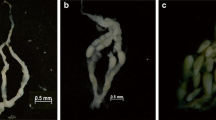Summary
-
1.
Data on the natural occurrence of the microgyne form ofMyrmica rubra L. are given, showing it to be more common than previously suspected.
-
2.
Morphometrics show that the microgynes are an isometric reduction of the normal queens.
-
3.
Experimental evidence is given to show that microgynes tend to breed true and that they have a queen effect that is similar to normal queens.
-
4.
The origin of the microgyne polymorphism is discussed and it is concluded that it is genetic, microgynes perhaps being an atavistic form of the species.
Résumé
-
1o
Des données sur la fréquence naturelle de la forme microgyne deMyrmica rubra L. montrent que cette forme est plus commune qu'on ne le supposait.
-
2o
Des données morphométriques montrent que les microgynes représentent une réduction isométrique des reines normales.
-
3o
Des preuves expérimentales montrent que les microgynes tendent à se reproduire véritablement et qu'elles ont une action royale semblable à celle des reines normales.
-
4o
L'origine du polymorphisme conduisant à la forme microgyne est discutée et l'auteur aboutit à l'idée d'un polymorphisme génétique, les microgynes étant peut-être une forme atavique de l'espèce.
Similar content being viewed by others
References
Brian (M. V.), 1954. — Studies of caste determination inMyrmica rubra L. 1. The growth of queens and males.Ins. Soc., 1, 101–122.—Brian (M. V.), 1955a. Studies of caste determination inMyrmica rubra L. 2. The growth of workers and intercastes.Ins. Soc., 2, 2–34.—Brian (M. V.), 1955b. Studies of caste determination inMyrmica rubra L. 3. Larval dormancy, winter size and vernalisation.Ins. Soc., 2, 85–114.—Brian (M. V.), 1956. Studies of caste determination inMyrmica rubra L. 4. Controlled larval nutrition.Ins. Soc., 3, 369–394.—Brian (M. V.), 1973. Caste control through worker attack in the antMyrmica. Ins. Soc., 20, 87–102. —Brian (M. V.), 1974. Brood-rearing behaviour in small cultures of the antMyrmica rubra L.Anim. Behav., 22, 879–889.—Brian (M. V.), 1975. Larval recognition by workers of the antMyrmica. Anim. Behav. (in press).
Brian (M. V.) andBrian (A. D.), 1949. — Observations on the taxonomy of the antsMyrmica rubra L. andM. laevinodis Nylander (Hymenoptera, Formicidae).Trans. R. ent. Soc. Lond., 100, 393–409.—Brian (M. V.) andBrian (A. D.), 1955. On the two forms macrogyna and microgyna of the antMyrmica rubra L.Evolution, 9, 280–290.
Buschinger (A.), 1970. — Neue Vorstellungen zur Evolution des Sozialparasitismus und der Dulosis bei Ameisen (Hym. Formicidae).Biol. Zbl., 88, 273–299.—Buschinger (A.), 1974. Zur Biologie der sozialparasitischen AmeiseLeptothorax goesswaldi Kutter (Hym. Formicidae).Ins. Soc., 21, 133–144.
Crozier (R. H.), 1970. — Karyotypes of twenty-one ant species (Hymenoptera, Formicidae), with revieews of the known ant Karyotypes.Can. J. Genet. Cytol., 12, 109–128.
Donisthorpe (H. St. J. K.), 1927. — British Ants. Routledge, Publ., London, 436 p.
Elmes (G. W.), 1973a. — Miniature queens of the antMyrmica rubra L. (Hymenoptera, Formicidae).Entomologist., 133–136.—Elmes (G. W.), 1973b. Observations on the density of queens in natural colonies ofMyrmica rubra L. (Hymenoptera, Formicidae).J. Anim. Ecol., 42, 761–771.—Elmes (G. W.), 1974a. The effect of colony population on caste size in three species ofMyrmica (Hymenoptera, Formicidae).Ins. Soc., 21, 213–230.—Elmes (G. W.) 1974b. The spatial distribution of a population of two ant species living in limestone grassland.Pedobiologia., 14, 412–418.
Hauschteck (E.), 1965. — Halbe haploide Chromosomenzahl im Hoden vonMyrmica sulcinodis Nyl. (Formicidae).Experientia, 21, 323–325.
Plateaux (L.), 1970. — Sur le polymorphisme social de la fourmiLeptothorax nylanderi (Forster). 1. Morphologie et biologie comparées des castes.Ann. Sci. Nat. Zool., 12, 373–478.—Plateaux (L.), 1971. Sur le polymorphisme social de la fourmiLeptothorax nylanderi (Forster). 2. Activité des ouvriers et déterminisme des castes.Ann. Sc. Nat. Zool., 13, 1–90.
Santschi (F.), 1931. — Notes sur le genreMyrmica Latreille.Rev. Suisse Zool., 38, 335–355.
Weir (J. S.), 1959. — Egg-masses and early larval growth inMyrmica.Ins. Soc., 6, 187–201.
Wheeler (W. M.), 1910. — Ants-their structure development and behaviour. Columbia University Press, Publ., New York, 663 p.
Yarrow (I. H. H.), 1955. — The type species of the ant genusMyrmica Latreille.Proc. R. ent. Soc. Lond, (B), 24, 113–115.
Author information
Authors and Affiliations
Rights and permissions
About this article
Cite this article
Elmes, G.W. Some observations on the microgyne form ofMyrmica rubra L. (Hymenoptera, Formicidae). Ins. Soc 23, 3–21 (1976). https://doi.org/10.1007/BF02283902
Received:
Accepted:
Issue Date:
DOI: https://doi.org/10.1007/BF02283902




